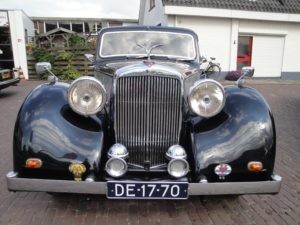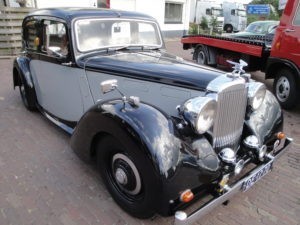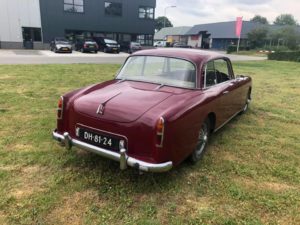From December 20 to February 2, the Louwman Museum presents a retrospective exhibition of seventeen Alvis automobiles. They date from the period 1920 to 1967 because of 100 Years Alvis. Alvis is known as an English manufacturer of high-quality cars. The manufacturer introduced a number of important innovations that are still used in the automotive industry. The exhibition shows a wonderful overview of the most important models that were provided with mostly typical traditional English bodies.
The start of Alvis
Alvis. The name alone caused a lot of discussion. The idea was that the name was made up of the 'Al' of 'aluminum' and 'fish' as from the Latin 'strength'. But the old divine Norwegian gunsmith Alvis would also be the namesake. Geoffrey de Freville, who founded the brand, insisted, however, that the name was just invented and meant nothing. But that statement was not exciting enough for everyone.
In 1919, engineer and entrepreneur Thomas George John started a small factory in Coventry. This produced the first cars in the following year. They were of high quality and equipped with a 1,5 liter four-cylinder engine with aluminum pistons and pressure lubrication. That was progressive at the time.
In the 1928s, Alvis took a leading role in the application of front-wheel drive racing cars operating at Brooklands, Le Mans and the Tourist Trophy. The experience gained in racing led to Alvis introducing the world's first front-wheel drive production car in XNUMX. That concept was viewed with 'suspicion and suspicion'. But it has settled down quite a bit by now.
From 1927, six-cylinder cars were also added to the delivery program.
The Alvis six-cylinder became the power source of a whole series of luxury Alvis six-cylinder models that made Alvis a noble brand until the outbreak of WWII. The six-cylinder were elegant and innovative. They had independent front suspension. And were the first to have fully synchronized gearboxes and servo-assisted brakes. But a little later there were overhead camshafts and optional (Roots) superchargers. And just like many suppliers in the high segment, Alvis delivered its cars bare. The bodywork was outsourced - often tailor-made - to external companies. These were, for example, Carbodies, Charlesworth Bodies, Cross & Ellis, Duncan Industries, E. Bertelli Ltd and Grose. But also Gurney Nutting, Hooper, Lancefield Coachworks, Martin Walter, Mayfair Carriage Co, Mulliners, Tickford, Vanden Plas, Weymann Fabric Bodies, and Arnold of Manchester.
After the war
After the war, Alvis caused a furore with his three-liter six-cylinder. Those blocks - from 1950 in a new chassis - remained the basis of the excellent drive until 1967. The 'saloon bodies' came from Mulliners, Tickford took care of the production of the 'dropheads'. Herman Graber from Switzerland also made some beautiful bodywork. They are now rare, sought after and very expensive.
The chassis were made in-house, but the bodywork was still supplied by various English bodybuilders
The models became bigger and more luxurious. There was competition with brands such as Bentley and Lagonda. In 1935 Alvis presented the first production car with a fully synchronized gearbox. A year later, the brand came with independent front suspension.
Production for the army
Just before the start of World War II, the emphasis at Alvis shifted to the production of aircraft engines and military vehicles. The car factory was completely destroyed by German bombings in 1940. After the war, the production of cars in the higher market segment started again. Once again it was decided to purchase the bodywork from third parties. In 1967 the production of Alvis passenger cars finally stopped. In the 1966s, Rover was in charge at Alvis. And Rover became part of British Leyland. At that time, the TF 21 launched in XNUMX was still considered very beautiful and good, but now dated. The Alvis passenger cars had had their day. The company was bought by United Scientific Holdings plc and, after a name change and some acquisitions, went on to build army and freight vehicles.
In the meantime, there are rumors that Alvis will become one of the many brands that may soon be 'back with a vengeance'.
The strange duck
From 1966 to 1992, the British Army employed Alvis Stalwarts. The 'identification card' stated 'High Mobility Load Carrier, 5 tons, 6 × 6'. The colossus affectionately known as 'Stollie' was amphibious and was powered by a 6,5 liter Rolls-Royce block. This made a Stalwart 63 km / h fast. There are nice videos about it on Youtube and an acquaintance once bought 9 because they were so cheap. He also has a set of crated Rolls-Royce blocks.
The exhibition '100 years of Alvis' was created on the initiative of and in close collaboration with the Alvis Owners Club Nederland.
Also an Alvis: the Stalwart









